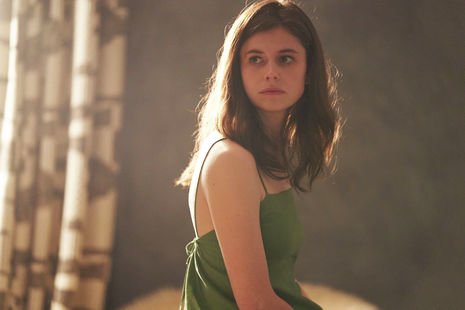Deconstructing the ‘Sally Rooney girl’
Fashion Editor Sarah Abbas unpicks the ‘Sally Rooney girl’ trope and investigates what it reveals about the rejection of mainstream fashion

The recent release of Sally Rooney’s Conversations With Friends adaptation prompted me to revisit the essential viewing show of the first lockdown: Normal People. As I nostalgically contemplated the impact left by the BBC Three limited series, I couldn’t help but notice the presence of the ‘Sally Rooney girl’ in my own life. Tote bags. Vintage clothes. Iced coffee. An insensitive yet insightful outlook on life. Long gone are the days of Zoey Deschanel; Marianne Sheridan has become the new blueprint. The on-screen adaptations of Rooney’s novels have assigned a distinct look for these leads—enabling us to recognise the ‘Sally Rooney girl’. The meticulously curated costume design for Marianne has created a tangible image in which this trope stems from. But is the Sally Rooney aesthetic more than just a look? With an urge to detach herself from the mainstream, perhaps this trope is just a revival of the ‘manic pixie dream girl’.
Dressing like a Sally Rooney character can be split into two categories: the jumper and jeans combo, or the ‘I’m spending summer at my family’s villa’ dress. The basic clothing gives these characters a blank template. Evading preconceived assumptions, they mould how they are perceived through their words and actions. We see Marianne undergo a complete fashion transformation as she enters university, yet she remains out of touch with the trends, allowing her mind to shine. Hollywood has deemed this impossible for the fashion-savvy girl (Legally Blonde is a notable exception). The dainty dresses work to disassociate Marianne from the fast fashion skin-tight dress worn by her ‘rivals’. Yet again, we see the film industry villainise hyper-femininity, burdening those characters with the ‘mean girl’ title.
“Is the rejection of fashion trends a self-preserving tactic?”
The ‘Sally Rooney girl’ is not flawless. On the contrary, her flaws are the foundation of her appeal. She is mysterious. She is brash. She is cold. Her strength lies in her intelligence. Her opinions. Her appearance is secondary yet she remains effortlessly chic. In fact, she rejects the idea of trying. She’s not ‘like other girls’.
Underneath the angsty young woman she portrays, there is a deep insecurity for her character. Sally Rooney’s leads often feel lost: perceiving the world from the sidelines. So is the rejection of mainstream style and adoption of an experimental aesthetic a way to find a label? Self-proclaiming themselves as loners, these characters reveal their true values through their interactions with others. They long to belong, to conform. So is the rejection of fashion trends a self-preserving tactic? A way to isolate yourself before being isolated?
“Marianne Sheridan has become the new blueprint”
To become the ‘Sally Rooney girl’ is to fall out of bed, pinch your cheeks for colour and be ready for the day. Yet perhaps only a select few are given permission to dress this way. In general, the ‘messy girl’ aesthetic is reserved for an exclusive group of people. In the aftermath of exams last year, I saw this illustrated in my own life when my group of friends took a trip to Grantchester, ready to swim in the unbearable heat. Not feeling up to it, I simply observed. Having completely submerged her head in water, one of my friends emerged from the river with her hair dripping. Yet, as it dried, it remained smooth and glossy—unaffected by the water. In that moment, I realised I could never be that girl. My temperamental hair cycles between frizzy and curly, requiring tiresome efforts to keep it in check. Unsurprisingly, I have developed an addiction to my hair straightener. It holds the key to be presentable, palatable to society. Sally Rooney has been criticised for the lack of diversity of her leads. Often white, slim and rich, this begs the question—is this aesthetic accessible to everyone?
This seemingly simple character trope reveals a great deal about the rejection of fashion. Sally Rooney’s characters once represented the self-effacing type. Written to be outsiders. This aesthetic primarily serves as a mask for the insecurity and inadequacy of Rooney’s leads.
For now, society will spin the superficial look of this trope into a trend: we will take the best parts of the looks and gloss over the intention behind them. Until society grows tired of the ‘Sally Rooney girl’, she will continue to dominate the alternative that is no longer the alternative. I can only hope that one day, we will also grow tired of the ‘not like other girls’ trend.
 News / Uni members slam ‘totalitarian’ recommendation to stop vet course 15 January 2026
News / Uni members slam ‘totalitarian’ recommendation to stop vet course 15 January 2026 Science / Why smart students keep failing to quit smoking15 January 2026
Science / Why smart students keep failing to quit smoking15 January 2026 News / Cambridge bus strikes continue into new year16 January 2026
News / Cambridge bus strikes continue into new year16 January 2026 Interviews / The Cambridge Cupid: what’s the secret to a great date?14 January 2026
Interviews / The Cambridge Cupid: what’s the secret to a great date?14 January 2026 Comment / Will the town and gown divide ever truly be resolved?12 January 2026
Comment / Will the town and gown divide ever truly be resolved?12 January 2026










